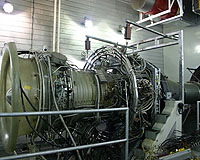 |
El Segundo CA (SPX) Oct 16, 2009 Boeing has announced that the third Wideband Global SATCOM (WGS) satellite built for the U.S. Air Force was shipped on Sept. 28 to Cape Canaveral Air Force Station, Fla., where it will be tested and prepared for a November launch. WGS-3 completes the initial constellation of three WGS satellites, which will provide high-capacity X-band and Ka-band communications to U.S. forces and allies across all current theaters of operation around the world. WGS-1 has been in operation over the Pacific since April 2008, and WGS-2 has been operating over the Middle East since August 2009. Both satellites have met or exceeded mission requirements throughout their testing and operational phases. "With its extraordinary increase in satellite communications capacity and flexibility, WGS helps our warfighters more effectively execute their missions on land, at sea and in the air," said Brig. Gen. Samuel Greaves, Vice Commander of the Air Force's Space and Missile Systems Center in Los Angeles. "This is another great milestone for the WGS team, which is performing superbly and setting the standards for getting these critical communications assets into space and into operational use." "WGS addresses our military's ever-growing appetite for high-bandwidth satellite communications," said Craig Cooning, vice president and general manager, Boeing Space and Intelligence Systems. "We're now working with the Air Force to determine how future WGS satellites could be enhanced to handle missions involving airborne intelligence, surveillance and reconnaissance, and communications-on-the-move." WGS-3 was flown on an Air Force C-5 transport from Boeing's Satellite Development Center in El Segundo to Cape Canaveral last month. Before being shipped, WGS-3 completed mission assurance reviews and challenging factory tests that simulated the stress of the satellite's mission. The satellite successfully completed vibration tests and thermal vacuum tests. The vibration tests replicated the stresses of launch. Thermal vacuum tests were conducted in an airless chamber, with the satellite operating at full power, and subjected to extremes of heat and cold to simulate the working conditions it will experience in space. At Cape Canaveral, WGS-3 will undergo about six weeks of prelaunch testing and processing, including fueling, encapsulation inside the launch vehicle fairing, and integration with the United Launch Alliance (ULA) Delta IV launch vehicle. Boeing built two previous WGS satellites and is currently building three more for the Air Force. WGS-3 is the final satellite in the Block I series. Three Block II satellites are planned for launch in 2011, 2012 and 2013. Share This Article With Planet Earth
Related Links Boeing Integrated Defense Systems Space Technology News - Applications and Research
 Tuning Gas Turbines By Satellite
Tuning Gas Turbines By SatelliteMumbai, India (SPX) Oct 14, 2009 In the first ever project of its type, GE Oil and Gas is using satellite connections to customer sites for the remote tuning and testing of gas turbine combustion systems at eleven (11) pipeline stations owned by Reliance Gas Transportation Infrastructure Limited (RGTIL) of Mumbai, India. The unique approach is enabling the project to be implemented with significantly more speed, whilst ... read more |
|
| The content herein, unless otherwise known to be public domain, are Copyright 1995-2009 - SpaceDaily. AFP and UPI Wire Stories are copyright Agence France-Presse and United Press International. ESA Portal Reports are copyright European Space Agency. All NASA sourced material is public domain. Additional copyrights may apply in whole or part to other bona fide parties. Advertising does not imply endorsement,agreement or approval of any opinions, statements or information provided by SpaceDaily on any Web page published or hosted by SpaceDaily. Privacy Statement |